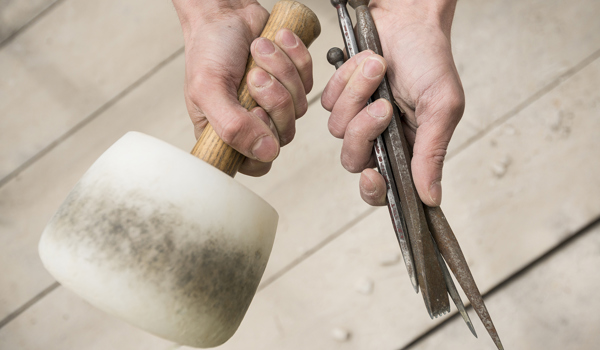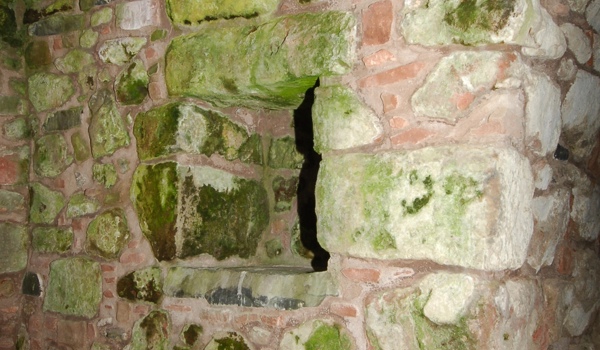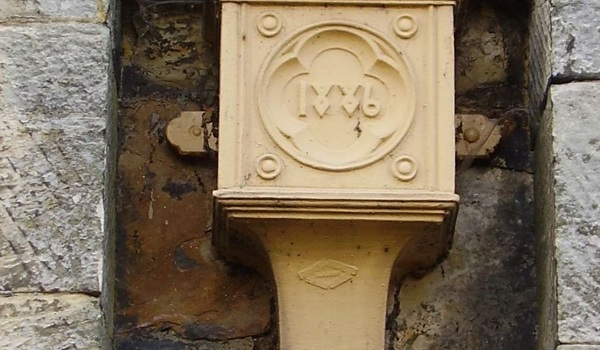- Home
- Building Advice
- Building components
- Roofs
- Pantile roofs
Pantile roofs
Overview
Overview
Pantiles were used to roof a significant number of traditional buildings in Scotland from the 1600s onwards – usually in areas where the weather is less severe. A well-maintained pantile roof will remain sound for many decades.
The double roll (S-shaped) fired clay pantiles are laid in their rows so that the downturn of one tile overlaps the upturn of the next. The peaks and troughs direct rainwater into the centre of the tile and channel it down the roof slope.
Regular inspections of a pantile roof will help to ensure that it continues to shed water effectively. Picking up problems early makes maintenance easier – and keeps repair costs down.
Loose and broken tiles are one of the most common causes of problems with pantile roofs. Failure of ‘parging’ can cause tiles to become loose. Tiles may get porous with age and break apart. Wind uplift, moss growth and cement mortar can also damage tiles. Decayed battens and fixings may leave tiles out of line.
Patching of the pantile roof will be necessary to keep it watertight if loose or broken tiles are found.
If second-hand or new replacement pantiles are needed for maintenance and repairs, these must closely match the originals. Tiles of a different profile shape won’t fit together properly, letting rainwater into the roof structure.
You should reuse original pantiles wherever possible – both to save money and to preserve the building’s character. Pantiles manufactured today are machine-made, so have a much more uniform look.
Update your personalised ad preferences to view content
- Next
-
Characteristics
Characteristics
Characteristics
Pantiles were used to roof a significant number of traditional buildings in Scotland. Pantile roofs are most often found in areas where the weather is less severe such as east central Scotland, the Lothians and Fife.
A pantile is a single-lap, S-shaped, fired clay tile. Single lap means that the bottom edge of any pantile only overlaps the row immediately below (plain tiles overlap two rows.)
Typical pantile roof design
Pantiles are laid in their rows so that the downturn of one pantile overlaps the upturn of the next. This forms a system of peaks and troughs that directs rainwater into the centre of the tile and channels it down the roof slope.
For a pantile roof to shed water effectively, the pantiles laid down in any column must be of a similar width.
Clay ridge tiles usually protect the apex of a pantile roof. These may be half round or V-shaped and are almost always bedded in lime mortar – as often are the lowest few rows of tiles. This held the tile more securely in place and offered extra protection against wind and water ingress.
Construction of pantile roofs
Pantiles are hung on a series of regularly spaced horizontal battens attached to the rafters. A small projecting nib on the tile’s reverse is used to hold it in position. Battens must be spaced evenly in single-lap tiling, so that each tile properly overlaps its neighbour in the row below.
Its construction means a pantile roof will let in more air than would a traditional slated roof or a modern equivalent. An insulated ceiling can be added to keep in more warmth, but care must be taken to avoid the risk of creating condensation. You should seek specialist advice before going ahead with any such work. Permissions for work may also be needed.
Today, it is common to fit underlay beneath the battens. This can lead to bats getting trapped, however, so you should also consider introducing bat-friendly measures.
Less common features
Pantiles were sometimes ‘parged’ or ‘torched’. This is where the underside of the tiles was filled with mortar between the roof battens to protect the joints. The use of parging varied by location and often depended on local weather and exposure conditions.
Some other roofs were made by bedding the pantiles in mortar directly onto sarking (wooden boards). To prevent damp and frost from eroding the mortar, the tiler would be careful to ensure that it was clear of any direct rainwater run-off.
A pantile roof would sometimes be ‘bellcast’, i.e. it would flatten out slightly near the eaves. This was often done using slate in place of pantiles for the bottom few rows. The slates would also protect better against the rain at the shallower pitch over the wall head and help to prevent lower rows of pantiles being lifted by the wind.
- Previous
-
Overview
- Next
-
Inspection
Inspection
Inspection
Your pantile roof should be checked regularly to make sure that any issues don’t have the chance to turn into problems, and to keep a lid on repair costs.
Always inspect your pantile roof at least once in the autumn, before the winter weather sets in. You should also make extra checks after any storms or gales.
Initial inspection
Begin by looking at the roof from outside, standing at ground level. Binoculars may allow you to see the pantiles better. Note down any concerns or signs of problems to discuss with the contractor who will carry out the repair work.
Check chimneys and flues and also any areas of slate roof or bituminous sheet flat roof.
Next, check the internal roof space for any signs of leaks. Stained roofing joinery, for example, won’t be visible from outside but may point to an external problem.
Roof-level inspection
Certain changes make clay pantiles more likely to break over time. Your roofing contractor should look for moss on the surface of tiles, which can cause dampness and speed up deterioration. Cement mortar is hard and doesn’t breathe, so tiles secured with it may show signs of damage or damp.
Pantiles may also break or become loose when lifted up by the wind.
Looking along each row and also down each column is a good way to check for any damaged, missing or slipped pantiles.
For a pantile roof to shed water effectively:
- in any row, the downturn of one pantile should overlap the upturn of the next
- the pantiles in each vertical column must be of a similar width to line up properly
Pantiles that are out of line are probably loose and in need of attention.
- Previous
-
Characteristics
- Next
-
Common causes of problems
Common causes of problems
Common causes of problems
Problems with pantile roofs are usually caused by damaged pantiles, the failure of ‘parging’ or decayed battens and fixings.
Damaged pantiles
The most common defect is loose or broken tiles. Tiles can become more porous with age and, in some cases, break apart. Pantiles may also break or become loose when lifted up by the wind.
Moss growing on the surface of pantiles can cause dampness and speed up deterioration. The easiest way to remove moss is by scrubbing the tiles with a bristle brush. Avoid using any chemicals as these may damage the tiles.
Cement mortar is hard and so can damage tiles, which are much softer (and it also makes future repairs more difficult). Lime mortar should be used instead for all retiling and repair work. As lime mortar is breathable, it lets moisture evaporate without damaging the tiles. It is also slightly flexible and can be more easily removed from tiles if repair work is necessary.
Failure of ‘parging’ or mortar bedding
Lime mortar used to ‘parge’ or ‘torch’ the underside of pantiles can sometimes fail.
Failure of the mortar can lead to:
- loose tiles
- draughts
- water penetration
A lime mortar similar to the original should be used to replace deteriorated sections. Using cement mortar instead could lead to condensation and deterioration of existing tiles.
Decayed battens and fixings
Movement in the roof structure can cause wear and tear in the battens and fixings. This can cause the pantiles to become loose and out of line, making the roof vulnerable to water penetration.
It’s important to identify and fix the cause of any such movement. Filling open junctions between the tiles with lime mortar can help to secure loose tiles. But we don’t recommend using foam or bituminous type treatments on the internal and external tile surfaces. Such applications make it difficult to reuse tiles in the future and can speed up timber decay by reducing ventilation.
- Previous
-
Inspection
- Next
-
Maintenance and repairs
Maintenance and repairs
Maintenance and repairs
A regularly maintained pantile roof will remain sound for many decades. Frequent inspections will help you to find problems early on and have them fixed quickly.
Patching of the pantile roof will be necessary to keep it watertight if loose or broken tiles are found. Care must be taken not to damage other tiles during the work.
Reuse vs replacement
You should reuse original pantiles wherever possible. This helps to keep costs down as well as to maintain the character of the building.
Moss on the surface of tiles can lead to dampness and speed up deterioration, and so must be removed before tiles are reused. Gentle scrubbing with a bristle brush is the easiest way to remove moss. Avoid using any chemicals as these may damage the tiles.
Any replacement pantiles that are needed should match the original tiles as closely as possible. This will ensure that replacement tiles link properly with the existing roof covering and helps to retain the look of the roof.
Replacements should match the originals in:
- size
- colour
- shape – i.e. the same double-roll (S-shaped) profile
Tiles of a different profile shape won’t fit together properly with the originals, and will let rainwater into the roof structure. Badly fitting tiles are also more likely to be lost in adverse weather, as the wind will lift them more easily.
Second-hand vs new pantiles
Second-hand pantiles, if used, must be compatible with the existing tiles. If a good match isn’t readily available, new pantiles may have to be used.
Most pantiles manufactured today are machine-made, producing regular sizes, shapes and colours. This makes new tiles stand out against the old. So it’s best to use new replacements only where they won’t be easily seen.
Securing pantiles
All tiles must be fixed securely to ensure the:
- safety of passers-by
- performance of the roof
Concrete replacement tiles must not be used on a pantile roof. These are often heavier and thicker than traditional clay tiles, and the roof structure may have to be strengthened to support the extra weight. (Concrete tiles also don’t weather or age in the same manner as clay, become porous more quickly and have a more limited life expectancy on the roof.)
Find out about hiring a contractor for roofing work.
- Previous
-
Common causes of problems
- Next
-
Permissions for work
Permissions for work
Permissions for work
If major retiling work is planned, you should check whether you must first apply for planning permission or any other type of consent. Listed building consent or conservation area consent may be needed, depending on the property and its location. Contact your planning authority to find out more.
Great care should be taken when removing existing pantiles from the roof. You will be able to reuse more of the original tiles if breakages are minimised.
Adding an insulated ceiling may improve the thermal efficiency of a building with a pantile roof. But adequate ventilation is needed to avoid the risk of creating condensation. A specialist can advise you how best to increase the level of insulation. Listed building consent may be necessary, and you may also need to discuss other building control issues with your planning authority.
Today, it is common to fit underlay beneath the battens. This can lead to bats getting trapped, however, so you should also consider introducing bat-friendly measures.
Learn more about listed building and conservation area consent.
- Previous
-
Maintenance and repairs
- Next
-
History
History
History
Pantiles were first used in Scotland in the early 1600s and a number of examples still exist from this time. Pantiles are most often found in areas with milder weather such as east central Scotland, the Lothians and Fife.
Imports from the continent, most notably Holland, most likely led to the earliest use of pantiles in Scotland. Use of the tiles spread inwards from the east coast ports where the stock would have arrived on boats.
By the 1700s, Scotland had its own pantile industry, and the material began to be used more widely. The drain tile and brick industry grew steadily alongside, as native clay was increasingly extracted and utilised.
Pantile production
Pantiles were originally made by hand from burnt clay in a similar way to a house brick. Traditionally, a manufacturer would make both items for general use within the local area.
This resulted in a great deal of regional variation in colour and overall size. Tile colour reflected the colour of the local clay – orange-red is most common, but blue-grey and black can also be found.
Their handmade nature means that original pantiles vary considerably in size and shape. But the profile used was always a double roll (S-shape).
Modern pantiles used in Scotland today are usually produced by machine to more precise specifications in factories in England.
- Previous
-
Permissions for work
- Next
-
Contacts
Contacts
Contacts
Get in touch if you have any questions. We will be happy to help.
- Technical Research Team
- 0131 668 8951
- technicalresearch@hes.scot
- Previous
-
History
- Next
-
Resources
Resources
Resources
Professional institutions
Roof Tile Association
The National Federation of Roofing Contractors
Confederation of Roofing Contractors
The Institute of Roofing
Publications
Inform guides
An introduction to conservation and maintenance of traditional buildings for complete beginners.
Pantiles and Maintaining a Pantiled Roof
Other resources
- Previous
-
Contacts
Related to Pantile roofs

Hiring a contractor
Get advice on hiring a contractor including choosing a contractor and managing the work.




